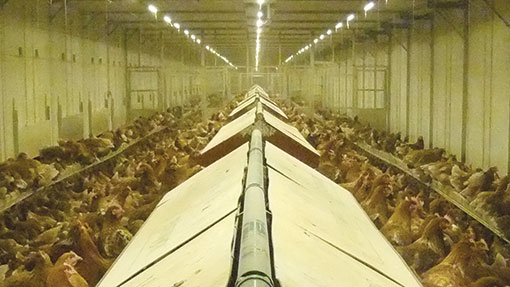LED lighting brings advantages to laying hens

Effective lighting for layers is essential to improve hen welfare and productivity.
As more evidence becomes available about the ability of lighting to improve hen welfare and productivity, producers are increasingly looking for systems that can deliver the control required, along with efficiency.
“Control of lighting duration and intensity in both rearing and laying units is a vital factor in producing and sustaining a productive flock,” says Charles MacLeod, general manager at Humphrey Pullets.
“As with nutrition and disease control, lighting should be viewed as an area that requires attention throughout the hens’ commercial life – from day-old chick to end of lay.”
In rear
Bristol University’s FeatherWel report, published in 2013, acknowledges that many factors in rear, including lighting, can affect pullet behaviour.
“We need to stimulate the chicks to eat and drink from day one and ensure that the lighting is bright – at least 20 lux – and that the chick is kept warm. Early growth is rapid and every effort is made to ensure that the physiological and immunological development of the pullet is not impaired.
“By 35 days the pullets reared for litter systems need to be experiencing 10-hour days and, providing that the development and growth is up to standard, lighting intensity can then be reduced.
“Changes must be gradual to avoid stressing the pullets. To enable this, without flickering or shadows developing, requires a well-designed lighting system with precise dimmers and accurate controls.”
In lay
Conditions in the laying house should have been replicated as closely as possible in the rearing unit, in particular the location of feeders and drinkers.
“Lighting should follow the same pattern as in rear,” says Mr MacLeod. “Duration is easily achieved, but intensity should be slightly brighter than that experienced in the latter weeks of rear. This can be more difficult to achieve and is particularly challenging in multi-tier units.
“The slight increase in intensity will help encourage the food and water intakes required to sustain the pullets through the rapid changes in physiology that culminate in the first egg.”
British Lion Quality Standards also include the provision of a twilight period to allow birds to settle overnight.
Advantages of LED lighting
- Reduced energy cost and consumption
- Reduced carbon footprint
- Reduced maintenance – longer lamp life at 35,000 hours of useful life
- Simulated lighting environmental controls – automated dawn-to-dusk settings with light level settings
- Improved light quality and output
Lighting choice
The importance of types of lighting used in poultry sheds is all too often underestimated. Producers have three main systems to consider:
- Incandescent bulbs – high energy costs, shorter life, not robust, easy to control and dim.
- Compact Fluorescent Lamp or Fluorescent Tube Lights – lower energy use and complex installation, with additional dimming circuits for tube lights. Compact Fluorescent Lamps cannot be dimmed and therefore require additional management such as painting the lights red or changing for a lower watt bulb.
- LED lighting – lower energy use and voltage, long life, high reliability, low maintenance, dimmable, mono-chromatic.
LED lighting is increasingly the preferred system, although the resulting benefits to welfare and productivity is still being tested.
“We have installed and are trialling the use of LED lights in a number of our own farms,” says Mr MacLeod. “Early indications are positive and we hope the full results, due later in the year, will confirm the benefits.
“Laying hens rely heavily on vision, and light is an important factor within their natural environment. Light affects physiology as well as behaviour, with duration, intensity and spectrum being the major influencers.
“LED lighting provides the poultry farmer, for the first time, with the ability to manipulate all these parameters, resulting in significant improvements in flock welfare and profitability.”
Virtuous circle
“No doubt, lighting can play a crucial role in reducing aggression and increasing productivity,” says Mr MacLeod. “It is important to ensure that, whatever light intensity is selected, it is even throughout the laying house and that any changes made are introduced gradually. The more you reduce pecking, the better the feather cover – and the better the feather cover, the less stress and the less pecking – it’s a virtuous circle.”
CASE STUDY: WATERLOO FARM, EAST SUSSEX
Humphrey Farms, working with lighting specialists LSL Co, installed a new LED lighting system at Waterloo Farm, East Sussex, in December 2012.
Operating a flat deck barn system, the original lighting consisted of 99 60W incandescent lamps. These were replaced with 9W LED linear strip lights, at a cost of just under £5,000.
Despite the cost, the companies predict the new system will generate an annual saving of almost £2,500, meaning the system will have paid for itself within two years.
RELATIVE PERFORMANCE OF THE TWO LIGHTING SYSTEMS
| Incandescent 60 watt filament | LED lighting system | Annual saving | |
|---|---|---|---|
| Carbon dioxide/year (MT) | 17.7 | 2.9 | 14.8 |
| KW of energy/year | 32,522 | 5,363 | 27,159 |
| Lifespan/hours a lamp | 1,600 | 35,000 | 20x longer lamp life |
| Annual cost* | £2,987 | £493 | £2,494 |
*based on energy unit cost of 0.087 p per kw/h
